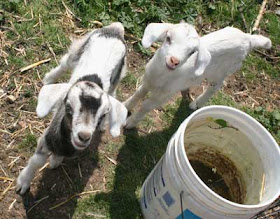 |
| Post and beam house next to the creek and gardens at Dripping Springs. |
Our
WWOOFer, Aaron, has a goal of seeing as many different kinds of gardens as he can this season. He wants to learn different methods of growing, not just for a home garden but also on a commercial scale. Basically he wants to learn everything he can about producing food and gardening. On Sunday I drove him down to visit our friends Mykul Crane and Mark Cain, who have Dripping Springs Farm. They grow both for the extensive farmers market in Fayetteville, Arkansas, and for their own CSA (
Community Supported Agriculture, where farmers take subscriptions from customers, and furnish the customer with weekly baskets of in season produce).
 |
| Mykul had just made a bouquet to send home to Josh's mom, Barbara. Aaron on the right. |
Their farm is remote, even more so than Long Creek Herb Farm. Far, far back in the woods, next to a crystal clear stream which furnishes the water for their irrigation of the farm are their fields and greenhouses. Dripping Springs Farm hosts garden interns throughout the growing season like we have here at our farm, although they usually have 4 to 6 interns for the entire season, often from South America, Japan or other countries and work through a completely different organization than WWOOF organization ( the letters stand for
World Wide Opportunities on Organic Farms).
 |
| Blueberry blossoms in the rain. |
The farm had originally been a blueberry farm with about 2 acres of blueberries. We've made annual berry picking trips there for years. But blueberries are labor intensive and finding enough pickers has been a challenge over the years to make the bushes profitable. They've removed most of the berries and planted more profitable crops such as cut flowers and vegetables. The farm has several acres of vegetables, some herbs and a lot of cut flowers.
 |
| A greenhouse with mostly spinach and salad greens. |
Greenhouse growing extends their season considerably. Because they live in a valley, they have a shorter growing season, with later frosts in the spring and earlier in the fall then we do here on the upland area. Hoop houses such as the one above don't require heat but can extend their growing season by as much as 2 months.
 |
| Aaron, Erica, Mark Cain, Mykul Crane, inside greenhouse while it was raining. |
Dripping Springs also sells produce to the Ozarks Natural Foods store in Fayetteville, AR. ONF has been around for as long as I can remember, offering organic foods and produce. In recent years they've been using local sources of fresh produce as possible.
 |
| Snapdragons and other flowers for cutting. |
At farmers market on the downtown square of Fayetteville, if you look for a long line of people at a booth, it is likely people waiting for Mykul or one of the interns to make a bouquet. Their method is to take dozens of buckets of freshly picked flowers and as a customer walks up, they order a bouquet by price. Mykul pulls individual stems of flowers from each bucket and creates a custom-made bouquet for each customer. People love it and will wait in line for Mykul's creations.
 |
| Deer fence, 10 ft. high. |
Deer have been a constant problem at Dripping Springs. A few years ago they put up a double electric fence, one low so the deer couldn't get a run at a jump, and another fence a bit higher. Over time the deer learned how to get over the electric fences, so last year with a agriculture grant, they built this high fence around the gardens and this one is working well.
 |
| Bamboo in background. |
Two years ago we had an especially hard winter freeze in January. Mark said they got -17 degrees, colder than we had at Long Creek. The photo on the right is of the bamboo in the background. They have about an acre or more of 30-40 ft tall bamboo and that freeze killed it back to the ground, the first time in 30 years. We have the same variety here at the farm and we didn't get nearly that cold and ours wasn't hurt. But look at the photo on the left, the line of brown at the top is all dead bamboo, with new coming up from the roots. They use bamboo for plant poles, constructing projects, etc. but grow way, way more bamboo than they can use. You can only eat just so many bamboo shoots!
 |
| Bamboo arbor. |
Above is a simple bamboo arbor our intern, Adam, and I made from bamboo we brought from Dripping Springs about 4 years ago. Bamboo is tough, makes excellent trellises and garden projects and will last for several years. I grew
achocha on it several seasons.
Dripping Springs received a good rain while Aaron and I visited. They needed the rain, they've been dry like we are at Long Creek Herb Farm. Happy spring.



















































